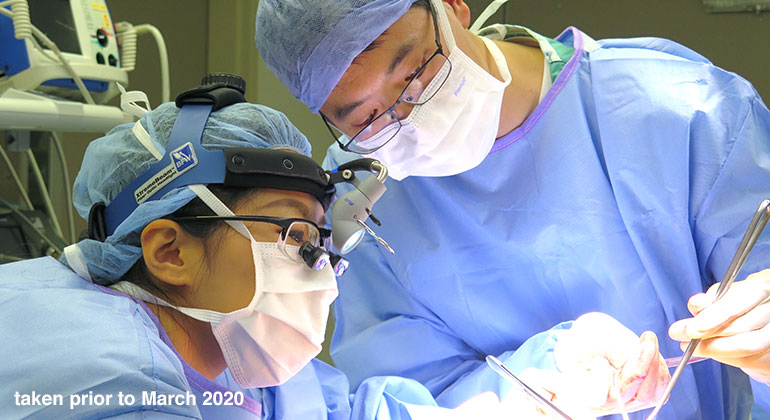Treatments for Snoring and Obstructive Sleep Apnea

Treatment for Snoring
Snoring is often the first sign of sleep apnea and the treatment of snoring begins with the determination of whether sleep apnea is present. The consequences of allowing sleep apnea to go untreated can be grave.
If sleep apnea is determined not to be a factor, snoring can be treated with a multitude of options:
- Oral appliances similar to a mouth guard can be made specifically for your bite to bring the jaw forward and open the airway further
- Radiofrequency technology is a short office procedure with local anesthesia used to tighten the tissue of the soft palate to reduce the vibrations that cause snoring. Surgery is an option for severe cases
- Radiofrequency in the office can also be used to open the nasal airway to improve breathing at night. Surgery is an option for severe cases
- Pillar implants – office based procedure to stiffen the palate
Treatment for Obstructive Sleep Apnea (OSA)
Every patient requires a customized treatment plan in the treatment of sleep apnea. The cause of airway obstruction varies among patients, and the management depends on the regions contributing to the obstruction of airflow. Areas of potential obstruction which may be discovered during the evaluation include: the nose, palate, tongue, upper and lower jaws, and vocal cords.
Nasal Procedures
Nasal obstruction can cause dysfunctional airflow in the upper airway and can play an important role in sleep apnea and snoring. The cause of nasal airflow problems can be a deviated nasal septum, enlarged nasal turbinates, a narrowed nasal opening, nasal polyps, allergies or other irritants causing swollen mucosa, or commonly a combination of them all.
Usually medical treatment options are the initial choice to target nasal obstruction, including nasal saline irrigations, nasal steroid sprays, oral allergy medications, and an allergy evaluation. External nasal dilators such as the Breathe Right® nasal strips can be used for some cases with narrowed nasal openings.
When medical treatment alone is not successful, surgery or an office procedure can improve the nasal airway. The most common nasal procedures include turbinate reduction, septoplasty, septorhinoplasty, and sinus surgery.
Palate
The tonsil and palate (roof of the mouth) are commonly addressed surgically in cases of obstructive sleep apnea and/or snoring with procedures like tonsillectomy, lateral pharyngoplasty, and uvulopalatal flap with the goal of strengthening and rearranging the palate tissue to reduce tissue collapsibility and minimize the possibility of side effects.
Tongue
In a large number of adult patients, a site of significant obstruction in OSA is the area behind the tongue. Surgical procedures are designed to make either the tongue firmer and less collapsible during sleep, or to remove tongue tissue (without effecting taste or swallowing) to reduce its volume and open the airway.
Robotic Tongue Surgery
As a leading center for surgical robotics, the Mt. Sinai Sleep Surgery Center is at the forefront of sleep surgery performing Transoral Robotic Surgery (TORS) for the tongue base. The use of robotic surgery for sleep apnea is IRB-approved and provides superior visualization and maximal tongue reduction for an improved airway.
Maxillomandibular Advancement
Maxillomandibular advancement is a surgical procedure where the upper (maxilla) and lower (mandible) jaws are moved forward, physically expanding the airway as a whole. It generally provides the most predictable and robust improvement amongst all the surgical procedures used to treat OSA.
However, because the procedure is more invasive, it is generally reserved for patients with moderate or severe OSA who have not obtained sufficient improvement after other procedures. In some patients with jaw abnormalities it can be a first-line surgical treatment. At the Mount Sinai Sleep Surgery Center, we use the latest technology to perform 3D imaging of the airway and jaws for surgical evaluation and planning in preparation for the surgery to optimize results.
People with sleep apnea can stop breathing more than 30 times an hour. Robotic surgery offers a permanent solution.